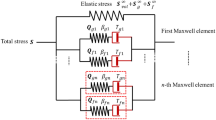Abstract
The aim of the work was a comparison of the possibility of using the hyperelastic material models to predict the mechanical behavior of a pig’s aorta in uniaxial tensile test conducted in vitro conditions. The isolated ascending and descending aortas were taken. The experimental curves were collected and used in the fitting procedure of three hyperelastic material models. The Mooney–Rivlin’s, the Ogden’s and the Yeoh’s models were applied. Two different approaches to a modeling procedure were used: 1—models were fitted to tensile data for all tested specimens of pig’s aorta and coefficients of models were averaged, with standard deviation parameter; 2—on the base of registered tensile curves, one average stress-stretch curve was determined and then hyperelastic material models were fitted, with registration of error fitting (\(R^{2}\)). The influence of the orientation of samples taken (longitudinal and transversal) to the central line of blood vessels on values of material parameters was estimated.
Access this chapter
Tax calculation will be finalised at checkout
Purchases are for personal use only
Similar content being viewed by others
References
Beaufort, H.W.L., Ferrara, A., Conti, M., Moll, F.L., Herwaarden, J.A, Figueroa, C.A., Bismuth, J., Auricchio, F., Trimarchi, S.: Comparative analysis of porcine and human thoracic aortic stiffness. Eur. J. Vasc. Endovasc. Surg. 55, 560–566 (2018)
Cosentino, F., Agnese, V., Raffa, G.M., Gentile, G., Bellavia, D., Zingales, M., Pilato, M., Pasta, S.: On the role of material properties in ascending thoracic aortic aneurysms. Comput. Biol. Med. 109, 70–78 (2019)
Courtial, E.J., Fanton, L., Orkisz, M., Douek, P.C., Huet, L., Fulchiron, R.: Hyper- viscoelastic behavior of healthy abdominal aorta. IRBM 37(3), 158–164 (2016)
Fitzpatrick, J.C., Clark, P.M., Capaldi, F.M.: Effect of decellularization protocol on the mechanical behavior of porcine descending aorta. Int. J. Biomater. 2010 (2010), 11 p. Article ID 620503
Gzik-Zroska, B., Joszko, K., Wolański, W., Gzik, M.: Development of new testing method of mechanical properties of porcine coronary arteries. Information Technologies in Medicine. Advances in Intelligent Systems and Computing, vol. 472, pp. 289–297. Springer International Publishing, Switzerland (2016)
Holzapfel, G., Sommer, G., Gasser, C., Regitnig, P.: Determination of layer-specific mechanical properties of human coronary arteries with nonatherosclerotic intimal thickening and related constitutive modeling. Am. J. Physiol.-Heart Circ. Physiol. 289, 2048–2058 (2005)
Humphrey, J., Holzapfel, G.: Mechanics, mechanobiology, and modeling of human abdominal aorta and aneurysms. J. Biomech. 45, 805–814 (2012)
Laksari, K., Shahmirzadi, D., Acosta, C.J., Konofagou, E.: Energy-based constitutive modelling of local material properties of canine aortas. R. Soc. Open Sci. 3, 160365. https://doi.org/10.1098/rsos.160365
Łagan, S., Liber-Kneć, A.: Mechanical properties of porcine aorta-influence of specimen taken orientation. Current Trends in Biomedical Engineering and Bioimages Analysis: proceedings of the 21st Polish Conference on Biocybernetics and Biomedical Engineering. Advances in Intelligent Systems and Computing, vol. 1033 , pp.279–287. Springer International Publishing, Switzerland (2020)
Macrae, R., Miller, K., Doyle, B.: methods in mechanical testing of arterial tissue: a review. Strain (Wiley Publishing Ltd.) 52, 380–399 (2016)
Papaharilaou, Y., Ekaterinaris, J.A., Manousaki, E., Katsamouris, A.N.: A decoupled fluid structure approach for estimating wall stress in abdominal aortic aneurysms. J. Biomech. 40(2), 367–377 (2007)
Polanczyk, A., Podgorski, M., Polanczyk, M., Veshkina, N., Zbicinski, I., Stefanczyk, L., Neumayer, C.: A novel method for describing biomechanical properties of the aortic wall based on the three-dimensional fluid-structure interaction model. Interact. Cardiovasc. Thorac. Surg. 28, 306–315 (2019)
Prendergast, P.J., Lally, C., Daly, S., Reid, A.J., Lee, T.C., Quinn, D., Dolan, F.: Analysis of prolapse in cardiovascular stents: a constitutive equation for vascular tissue and finite-element modelling. J. Biomech. Eng. 125, 692 (2003)
Raghavan, M.L., Vorp, D.A.: Toward a biomechanical tool to evaluate rupture potential of abdominal aortic aneurysm: identification of a finite strain constitutive model and evaluation of its applicability. J. Biomech. 33(4), 475–482 (2000)
Schmidt, T., Pandya, D., Balzani, D.: Influence of isotropic and anisotropic material models on the mechanical response in arterial walls as a result of supraphysiological loadings. Mech. Res. Commun. 64, 29–37 (2015)
Author information
Authors and Affiliations
Corresponding author
Editor information
Editors and Affiliations
Rights and permissions
Copyright information
© 2021 The Editor(s) (if applicable) and The Author(s), under exclusive license to Springer Nature Switzerland AG
About this paper
Cite this paper
Łagan, S., Liber-Kneć, A. (2021). The Use of Hyperelastic Material Models for Estimation of Pig Aorta Biomechanical Behavior. In: Gzik, M., Paszenda, Z., Pietka, E., Tkacz, E., Milewski, K. (eds) Innovations in Biomedical Engineering. AAB 2020. Advances in Intelligent Systems and Computing, vol 1223. Springer, Cham. https://doi.org/10.1007/978-3-030-52180-6_8
Download citation
DOI: https://doi.org/10.1007/978-3-030-52180-6_8
Published:
Publisher Name: Springer, Cham
Print ISBN: 978-3-030-52179-0
Online ISBN: 978-3-030-52180-6
eBook Packages: Intelligent Technologies and RoboticsIntelligent Technologies and Robotics (R0)




